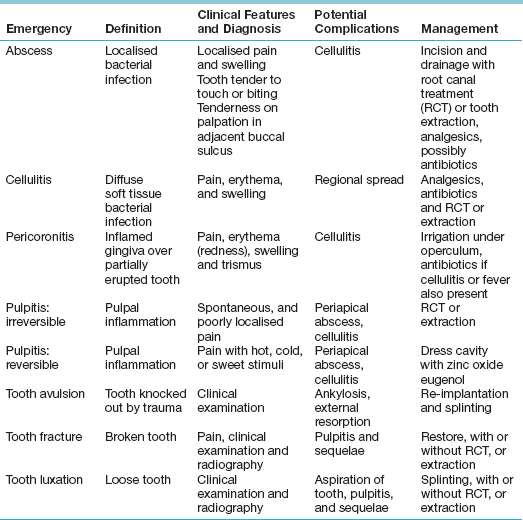CHAPTER 16 Dental Emergencies
In the context of dental emergencies, for the purpose of the dental nurse qualification, the NEBDN syllabus specifically mentions having an understanding of:
However, we believe it will be helpful for you and others to have background knowledge of the commonplace dental emergencies covered in this chapter. This will help you care better for the patients who present with these conditions. Therefore, we recommend that you read this chapter to learn about the diagnosis and management of commonplace dental emergencies.
Introduction
Most dental emergencies relate to trauma or pain from a tooth affecting a person at home, work, while studying, or while doing leisure activities. The conditions that commonly cause dental pain are listed in Table 16.1 and these appear to be increasing.
Other dental emergencies such as bleeding are usually related to operative procedures (pp. 46, 61). These are also discussed in this chapter. Allergies are discussed in Chapter 2 (see p. 56).
Trauma
• Trauma is especially common in young males, particularly those who have been using alcohol or other recreational drugs. The face, mouth and teeth are often involved.
• Avoiding alcohol and drugs, and routinely using safety measures such as seat belts and child safety harnesses, can reduce the risk of trauma as a result of road traffic accidents.
• Many other injuries occur in contact sports or recreational activities and could be prevented through the use of protective safety equipment such as helmets.
• Mouth guards made of soft plastic adapted to fit the shape of the upper teeth, protect both the lips and teeth. Pre-formed guards are available, or a clinician can create a custom-fit guard.
General Management of a Patient with Trauma
• Exclude head injury (particularly assessing any change of consciousness) or other serious injuries.
General Examination
Immediate life-threatening problems in a patient with a jaw injury include:
Management of Maxillo-Facial Injuries
Jaw fractures
• Fractures of the mandible – these are among the commonest jaw fractures after trauma. Patients with fractures of the mandible rarely have serious injuries to other parts of their body; however, alcohol or other drugs may be involved.
• Fractures of the middle or upper third of facial skeleton – these are more common after severe trauma (particularly road accidents or war injuries). They are more likely to be associated with life-threatening problems because of:
Jaw fractures are usually managed by open reduction and internal fixation (ORIF).
Injuries to teeth
Stay updated, free dental videos. Join our Telegram channel

VIDEdental - Online dental courses







